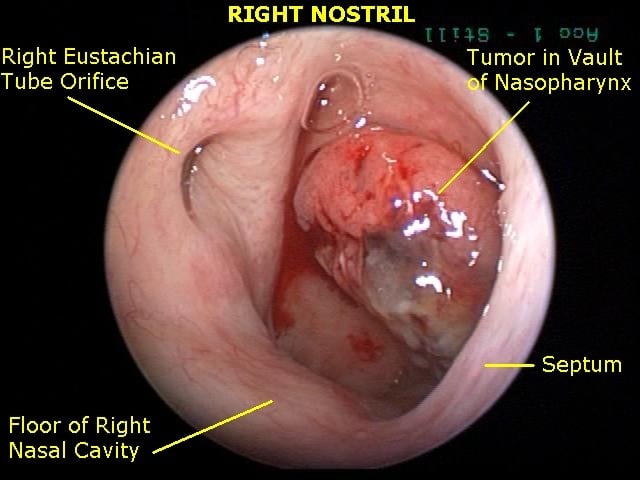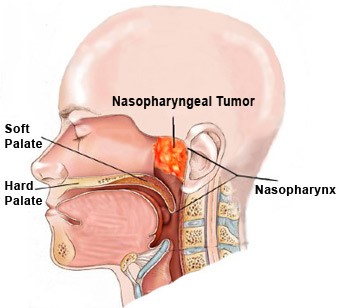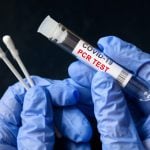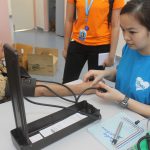Introduction to NPC
- Nasopharyngeal carcinoma (NPC) is a Nonlymphomatous squamous cell carcinoma that occurs in the epithelial lining of the Nasopharynx.
- An Epstein-Barr virus-associated malignancy.
- High prevalence in southern China, Southeast Asia, and the Middle East/North Africa.
- Detected in the advanced stage, outcome of treatment not favourable.
- 4th most frequent cancer in Malaysia (5.2% out of all cancer), 3rd most frequent cancer among Chinese male (10.7% of cancer among Chinese male).
- Primary area of occurrence is in the pharyngeal recess (Rosenmüller’s fossa), posteromedial to the medial crura of the Eustachian tube opening in the nasopharynx.
Figure 1: Endoscopic view of Nasopharynx
Figure 2: Location of NPC
- The incidence of NPC reportedly remains high among Chinese people even those who have migrated from Southern China to Southeast Asia or North America.
- Racial as well as environmental factors play a role in the cause of the disease.
- The mainstay of NPC treatment is radiotherapy and Chemotherapy
What is NPC? What is the risk of getting NPC?
- NPC is a relatively rare malignancy in most parts of the world. It has an incidence of 0.5 to 2 per 100,000 in the United States
- However, it is endemic in many geographical regions, including Southern China, Southeast Asia, Japan, and the Middle East/North Africa with an incidence of between 50 per 100,000 in the Guangdong Province of Southern China.
- Emigration from high- to low-incidence areas such as the United States reduces the incidence of NPC in first-generation Chinese, but it still remains at seven-times the rate in Caucasians.
- NPC presents as a complex disease caused by an interaction between chronic infection with oncogenic gamma herpes virus, Epstein-Barr virus (EBV) and environmental and genetic factors involving a multistep carcinogenic process.
- EBV exists worldwide, infecting over 95% of the global adult population.
- Although primary EBV infection is typically subclinical, the virus is associated with the later development of several malignancies, including NPC.
- It is transmitted by saliva, and its primary infection occurs during childhood with replication of the virus in the oropharyngeal lining cells, followed by a latent infection of B lymphocytes (primary target of EBV).
- Non-viral exposure associated with the risk of NPC involves the consumption of salt-preserved fish.
Figure 3: salted fish
- The carcinogenic potential of salt-preserved fish is supported by experiments in rats, which develop malignant nasal and nasopharyngeal tumors after salted fish consumption.
- The process of salt preservation is inefficient, allowing fish and other foods to become partially putrefied. These foods accumulate nitrosamines, a known carcinogens that promote the growth of NPC.
- Several genes like human leukocyte antigen (HLA) class I genes in certain populations are linked to an increased in risk of developing NPC. For example,the HLA-A2 allele, particularly HLA-A0207.
What are the signs and symptoms? About 3 out of 4 people with NPC presenting complain in their first visit to their doctor is a lump or mass in the upper neck. lumps may be on both sides towards the back. They are usually not tender or painful. 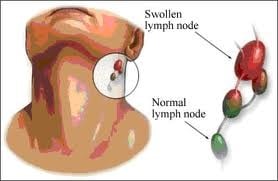
Figure 4: lump or swelling in the neck
One study indicated the following symptoms:
- Nasal symptoms: including bleeding, obstruction, and discharge (78%)
- Ear symptoms: including infection, deafness, and tinnitus (73%)
- Neck Swelling (63%)
- Headaches (61%)
Sham JS, Poon YF, Wei WI, Choy D. Nasopharyngeal carcinoma in young patients. Cancer. Jun 1 1990;65(11):2606-10. [Medline]. A. Nasal Symptoms : 78% 1. Epistaxis- Bleeding from Nose 2. Block Nose or Stuffiness and Discharge 3. Facial Numbness and pain B. Ear Symptoms: Recurrent unilateral Infection, deafness, and tinnitus (73%) C. Swelling over the Neck (61%) Other possible symptoms of NPC include: 1. Hearing loss, ringing in the ear, or feeling of fullness in the ear (especially on one side only) 2. Ear infections that keep coming back 3. Nosebleeds 4. Headache 5. Facial pain or numbness 6. Trouble opening the mouth 7. Blurred or double vision How is NPC diagnosed?
- Endoscopic examination A flexible fibre-optic tube being introduced into the nose for internal viewing of the nose and biopsy taken from the mass in the Nasopharynx.
- CT scan of head and neck, MRI head and neck and PET-CT scan to look for the extent of the disease in the body.
- Serological Blood test IgA antibody titers to EBV viral capsid antigen (EBV-IgA-VCA) and EBV early antigen (EBV-EA) in immunofluorescent assays may be used for the serologic screening of NPC
- Narrow-band imaging (NBI) Early recurrent lesions of NPC is one of a novel technique that enhances the diagnostic sensitivity of endoscopes for characterizing tissues using narrow-bandwidth filters in a sequential red-green-blue illumination system.
- Molecular biomarkers are under examination as a new tool for the detection of early NPC lesions.
How is NPC treated? Radiotherapy High energy x-rays used to kill cancer cells and to grow again. It is the main treatment for NPC as response of NPC to it is very high. Newer radiotherapy technique called Intensity Modulated Radiotherapy (IMRT) are used frequently to reduce the side effects of radiotherapy. Chemotherapy They are toxic drugs to kill cancer cells. Chemotherapy in addition to radiotherapy improves the treatment results in patients with nasopharyngeal carcinoma and advanced cancer which had spread to other organs for example bones, liver and lungs Surgery Reserved in cases of recurrence of NPC. What is the Outcome (Prognosis) After Treatment?
| Stage | Treatment |
| Early stage | Small and localised NPC has high survival rate after radiotherapy and chemotherapy is 90%. |
| Intermediate stage | Spread of NPC to other neighbouring organs or the lymph glands in the neck. Survival rate after radiotherapy and chemotherapy is 50 to 75%. |
| Late stage | NPC spreading all over the body has a poor survival rate of 10% in patients who survive 5 years. |
Prepared by: Moo Yong Hoong Foong, Semester 7 Medical Student at International Medical University Dr Rafiqahmed Abdulkarim Vasiwala, Senior Lecturer in ENT, International Medical University





